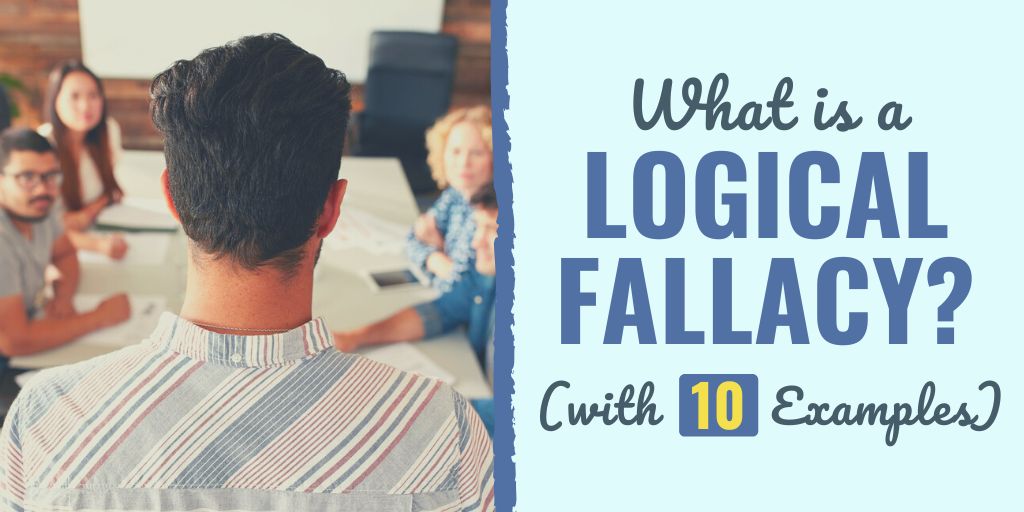There might be affiliate links on this page, which means we get a small commission of anything you buy. As an Amazon Associate we earn from qualifying purchases. Please do your own research before making any online purchase.
Have you ever made a mistake at work and then thought you were surely going to be fired?
I was recently in a bind at work and my boss asked to have a meeting with me the following morning. I was positive I was going to get fired–or, at least get into big trouble. I worried all night about how the meeting was going to go and how I was going to defend myself and my work.
It turned out that the meeting was completely unrelated to the dilemma, and it actually wasn’t an important meeting at all.
My error in reasoning here is an example of a logical fallacy. While logical fallacies are often used to persuade others, there can be instances–such as this one–where you actually persuade yourself.
A logical fallacy is a common error in reasoning that often occurs in teaching environments, on internet forums, and, most relevantly, presidential debates.
In this article, we will talk about what a logical fallacy is and why it’s important for you to be able to recognize when someone is using one in a conversation. Then, we will look at 10 examples of what a logical fallacy is so you will have a better idea of how to spot them.
Let’s get started.
What is a Logical Fallacy?
A logical fallacy is a flawed reasoning or false assumption that doesn’t prove anything, even though it may seem to initially make sense on the surface.
These false claims are often very persuasive to a casual listener, so being able to identify logical fallacies is a valuable skill, as it can allow you to effectively evaluate other people’s arguments.
There are several types of logical fallacies, which each has a unique way to trick people into agreeing with an argument. While some appear to be blatant inconsistencies, others go unnoticed, so they’re able to sneak their way into everyday conversations without being detected.
Sometimes people use logical fallacies unintentionally–however, they’re often used during debates or arguments to coax others into thinking a certain way.
It is easy to make the mistake of committing a fallacy of your own if you have strong feelings about a certain topic. When a conclusion seems obvious to you, you’re likely to assume that it’s true and not look for hard evidence to support the claim.
It’s important to recognize this tendency in order to maintain the validity of your arguments.
Why is it Important to Recognize a Logical Fallacy?
Being able to spot a logical fallacy will help you separate facts from well-dressed fiction. Not only will it help you take a critical look at other people’s arguments, it will also help you make more valid arguments of your own.
It will be especially important to be able to recognize logical fallacies during this upcoming year’s political climate where there will be a lot of arguments on both sides of the political spectrum.
In order to accurately detect the logical fallacies that are claimed in political debates, not only do you have to listen from an impartial standpoint, but you also have to control any emotions that may be evoked by a candidate’s claims.
You also need to be able to put your opinion about a candidate’s character to the side when they’re talking about a political issue because it can be easy to look for (and find) logical fallacies in arguments made by someone you don’t like, and similarly, it can be easy to ignore or disregard a fallacy spoken by a candidate that you do like.
You have to have the self-awareness to recognize when your opinion of a person is shading your judgement of their claim. If you’re good at spotting logical fallacies, you won’t be prone to making this mistake.
One logical fallacy that you can probably recognize from past presidential elections is when a candidate uses personal attacks against another to discredit an argument.
For example, let’s say one candidate says, “Mr. X’s plan for health care is ridiculous. What would a government employee know about the struggle that people face to obtain good health care at a reasonable cost?”
In this example, there is no argument made against the proposed health care plan. The only information that has been offered is that the person proposing the plan probably isn’t facing the struggle of obtaining health care, which doesn’t say anything about the quality of their proposal.
Let’s look at some specific examples of logical fallacies that you will probably find to be familiar, but you may not have realized these arguments had a name.
10 Examples of Logical Fallacies
Before we look further into some examples, check out this video of the top 10 logical fallacies that people try to claim to persuade others.
1. Circular Reasoning
If someone is trying to convince you of something using circular reasoning, instead of offering you proof or anything to back up their argument, they just repeat their final point over and over.
For example, “Opium makes people sleepy because it has sleep-promoting attributes.”
This argument doesn’t give a reason for how or why opium induces sleep. Instead, it basically says that: It is because it is. No evidence is given to verify the original fact, which makes any argument using circular reasoning invalid.
Here are some more circular reasoning (or ‘”begging the question) examples to learn from.
2. Hasty Generalization
A hasty generalization is when someone comes to a conclusion without examining all of the facts. Also known as overgeneralization, this is where biases and discrimination often become a factor.
Let’s say you are new to a town and the first group of people you see is children, you could assume that everyone who lives in the town is a child.
However, your knowledge about the town thus far is extremely limited and you’re not looking at any data aside from your initial observation to prove your conclusion otherwise.
To avoid making a hasty generalization, it’s important to fully research any topic and recognize a wide variety of facts and perspectives.
If you want to learn more, here's our article about hasty generalizations and how to respond to them.
3. Slippery Slope
A slippery slope argument is one that assumes something catastrophic will result from an event that is insignificant when looking at the bigger picture.
If you related to the first example given in this article of assuming you were going to get fired over a small mistake at work, then you may be able to identify with this logical fallacy.
Another example of this would be an argument suggesting that if you don’t study every day of the week, you won’t do well in school. And, if you don’t do well in school, you won’t get a good job.
Since you will be living without a good job, you will be homeless. This suggests that not studying every day will result in eventually becoming homeless.
However, this argument is making a lot of assumptions and taking them to an extreme measure. It is leaving out all other factors that would have to occur to result in a person becoming homeless.
4. Straw Man
This logical fallacy uses the technique of twisting someone else’s case to make it easier to disprove. Essentially, the person who is engaging in the straw man logical fallacy is arguing against a point that the other person didn’t try to make.

For example, if one person claims standardized testing shouldn’t be given to students to measure their achievement, someone who is making a straw man argument in return might say, “If we don’t give any tests in schools, students will not take responsibility for their learning and they won’t develop the skills that are needed in adulthood.”
This response is aiming to weaken an opponent’s rational argument by suggesting the other person is making a claim that they’re not.
This may seem effective to the person making the straw man claim and to an audience simply because the opponent is being told that he or she is wrong, followed by a statement that would make sense in a different context.
5. Ad Hominem
The example given above in a potential political debate regarding health care is an ad hominem logical fallacy. This type of argument attacks someone else’s character in an attempt to cast doubts upon their claim.
For example, the recommendations of a male pediatrician could be discredited by a mother who feels that the doctor can’t understand her child because he has never been a mother.
By discrediting the doctor in this way, the mother is attempting to erode the doctor’s opinion without really talking about it or even considering it.
6. False Dichotomy
In an argument using false dichotomy, only two options are presented to an opponent without any consideration of other potential options. This means the available considerations have been narrowed down only into options whose answers are in the speaker’s favor to attack their opponent.
For example, “You either fully support me, or you are against me.” Or, “I thought you cared about other people, but you don’t donate money to charity on a regular basis.”
These two examples don’t offer any further options, such as, “I support most of your decisions, but not all of them.” Or, “I donate my time, which is often more valuable than a financial contribution.”
If you want to learn more about his topic, here's an article about false dichotomy examples and how to counter them.
7. Appeal to Emotion
An appeal to emotion is when someone attempts to persuade others by using language that is often associated with emotions. This argument often comes in the form of, “This is true, because if it’s not true, you will be very sad.”
So, “I should have another chance to turn in this paper because I was so busy last week with work from other classes, family obligations, and my partner dumped me.”
While a listener may feel that the speaker’s situation is unusual and not very fair, the fact that the student had a bad week doesn’t make a strong objective argument.
Check out this post for more examples of the appeal to emotion fallacy.
8. Equivocation
An argument using equivocation is presented in vague terms, resulting in a misleading claim. Examples of this type of logical fallacy are a bit confusing… because they’re meant to be.
“Eating a hot dog is better than nothing, but nothing is better than eating a hamburger. This must mean that hot dogs are better than hamburgers.”

The ambiguous term in this argument is “nothing”. Does the person mean that eating a hot dog is better than eating nothing? Or, there is nothing better than a hot dog? They would rather eat nothing than have a hamburger? Or a hamburger is the best food in the world? This statement could be interpreted both ways.
Closely related to equivocation is the false equivalence fallacy. Check out this post on false equivalence examples to learn more.
9. Bandwagon Appeal
Bandwagon appeal uses peer pressure to influence others to accept or reject a claim. For example, “A lot of people purchase the extended warranty, so it must be smart to do so.” Or, “My entire family believes X, Y, and Z, so anyone who doesn’t believe these things is wrong.
However, there is no factual basis offered as to why the original claims are true. The claims simply rely on other people’s opinions.
If you want to learn more, read our article about bandwagon fallacy examples.
10. False Analogy
This logical fallacy uses the reasoning that because two otherwise unalike factors share one similarity, they must actually be similar in nature.
For example, “Both dogs and people respond best to discipline, so they must be alike.”
When looking at this argument objectively and considering all of the differences between humans and dogs, you can recognize that there is no merit to this claim.
Another example of logical fallacy is Sunk Cost Fallacy, if you want to learn more about this, check out this video:
Learn More About Logical Fallacies
If you want to expand your knowledge about the different logical fallacies and learn how to avoid them, check out our other posts:
- 5 Appeal to Nature Fallacy Examples in Media and Life
- 6 Outcome Bias Examples That Can Negatively Impact Your Decisions
- 7 Self-Serving Bias Examples You See Throughout Life
- 7 Omission Bias Examples That Negatively Impact Your Life
- 6 Authority Bias Examples That Might Impact Your Decisions
- 7 False Cause Fallacy Examples
- 7 Appeal to Ignorance Fallacy Examples
- 7 Appeal to Common Sense Logical Fallacy Examples
- 5 Post Hoc Fallacy Examples (and How to Respond to This Argument)
- Gambler’s Fallacy: 5 Examples and How to Avoid It
- 5 Appeal to Anger Fallacy Examples Throughout Life
- 7 Halo Effect Bias Examples in Your Daily Life
- 7 Poisoning the Well Examples Throughout Your Life
- 7 Survivorship Bias Examples You See in the Real World
- 7 Dunning Kruger Effect Examples in Your Life
- 7 Either Or (“False Dilemma”) Fallacy Examples in Real Life
- 5 Cui Bono Fallacy Examples to Find Out “Who Will Benefit”
- 6 Anchoring Bias Examples That Impact Your Decisions
- 7 Virtue Signaling Examples in Everyday Life
- 7 Cherry Picking Fallacy Examples for When People Ignore Evidence
- 9 Appeal to Pity Fallacy (“Ad Misericordiam”) Examples in Everyday Life
- 9 Loaded Question Fallacy Examples in Life and Media
- 9 Confirmation Bias Fallacy Examples In Everyday Life
- 5 Red Herring Fallacy Examples to Fight Irrelevant Information
- 9 Middle Ground Fallacy Examples to Spot During an Argument
- 6 Straw Man Fallacy Examples & How You Can Respond
Final Thoughts on Logical Fallacies
Knowing how to spot logical fallacies can help you make more informed decisions both in politics and in your everyday life. While this list is not exhaustive, it should help you identify missteps in logic that are often used by people to convince others of their beliefs.
If you want to check your own work for logical fallacies, start by playing the devil’s advocate to your argument. Does any part of your argument seem weak? If so, revise those portions by making the extent of your claims match the extent of your argument.
If you can figure out what types of logical fallacies you tend to use, make sure to specifically look for these fallacies when you’re engaging in a debate. For example, I know that I am prone to making a slippery slope argument, so I look out for such claims in my own arguments.
Finally, don’t forget to objectively reflect on your opinion of another person’s character before agreeing or disagreeing with what they’re saying. Your opinion of someone can be blinding.
Keep these logical fallacies in mind as we move toward the electoral debates. Doing so may help you realize your political position isn’t exactly what you have always assumed.
Finally, if you want a simple process to counter the logical fallacies and cognitive biases you encounter in life, then follow this 7-step process to develop the critical thinking skills habit.

Connie Stemmle is a professional editor, freelance writer and ghostwriter. She holds a BS in Marketing and a Master’s Degree in Social Work. When she is not writing, Connie is either spending time with her 4-year-old daughter, running, or making efforts in her community to promote social justice.


